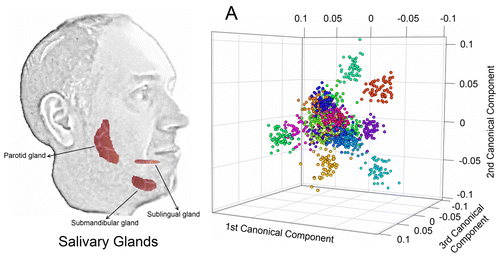Searching for signs of disease in spit

Testing for health conditions usually involves needles, X-rays and other invasive or uncomfortable measures. To make diagnostics less burdensome for patients, scientists are developing alternatives, looking for disease markers in urine—and even spit. Now a study, appearing in ACS' Journal of Proteome Research, demonstrates for the first time that individuals may have saliva "fingerprints." The finding suggests that identifying changes in these baseline fingerprints could someday be a reliable way to detect disease.
In the search for non-invasive and less stress-inducing ways to detect disease, much effort has focused on urine testing. Individuals' urine samples have specific metabolic signatures that can become altered when a person develops a health problem. But compounds in urine can also vary depending on factors such as diet and environment. Saliva has similar potential as an easy-to-access fluid that changes in response to health conditions, but could be less affected by diet and the environment. Paola Turano, Kurt Zatloukal and colleagues wanted to investigate how reliable this route might be.
The researchers sampled saliva and urine from 23 healthy volunteers multiple times a day over 10 days. The molecular signatures of saliva and urine were distinct and consistent for each participant. But profiles from spit samples changed less due to dietary variations than those from urine. Although longer-term research would be needed, this initial work on saliva fingerprints suggests that they could be useful in searching for signs of disease, say the researchers.
More information: Sandra Wallner-Liebmann et al. Individual Human Metabolic Phenotype Analyzed byH NMR of Saliva Samples, Journal of Proteome Research (2016). DOI: 10.1021/acs.jproteome.5b01060
Abstract
Saliva is an important physiological fluid that contains a complex mixture of analytes that may produce a characteristic individual signature. In recent years, it has been demonstrated that urine possesses a clear signature of the individual metabolic phenotype. Here NMR-based metabolomics was employed to analyze saliva from 23 healthy volunteers. About six saliva samples were collected daily from each individual for 10 consecutive days: 7 days in a real-life situation (days 1–7, Phase I) and 3 days (days 8–10, Phase II) under a standardized diet plus a physical exercise program at day 10. The result is the first demonstration of the existence of an individual metabolic phenotype in saliva. A systematic comparative analysis with urine samples from the same collection scheme demonstrates that the individual phenotype in saliva is slightly weaker than that in urine but less influenced by diet.
Journal information: Journal of Proteome Research
Provided by American Chemical Society

















